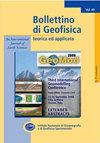遗传算法全波形反演:不确定性估计及结果验证
IF 0.7
4区 地球科学
Q4 GEOCHEMISTRY & GEOPHYSICS
引用次数: 14
摘要
我们将遗传算法-全波形反演(GA-FWI)置于概率框架中,通过多步骤程序,使我们能够估计模型空间中的后验概率分布(PPD)。由于遗传算法不是马尔可夫链蒙特卡罗方法,因此有必要通过Gibbs采样器(GS)对模型空间进行重采样来改进遗传算法估计的PPD (GA PPD),从而得到GA+GS PPD。我们将此方法应用于两个声学二维模型,一个包体模型和一个Marmousi模型,我们发现推导出的ppd与地震光照变化引起的分辨率变化之间有很好的一致性。最后,我们从得到的ppd中随机提取几个模型,开始许多局部全波形反演(LFWIs),从而产生最终的高分辨率模型。然后使用这组模型对最终不确定性(GA+GS+LFWI PPD)进行数值估计。由GA优化得到的多模态和宽ppd在LFWI后变为单模态和窄ppd,并且在地下照明良好的部分,最终的GA+GS+LFWI ppd包含真实的模型参数。这证实了GA优化在寻找适合作为LFWI输入的速度模型方面的能力。本文章由计算机程序翻译,如有差异,请以英文原文为准。
Genetic algorithm full-waveform inversion: uncertainty estimation and validation of the results
We cast the genetic algorithm-full waveform inversion (GA-FWI) in a probabilistic framework that through a multi-step procedure, allows us to estimate the posterior probability distribution (PPD) in model space. Since GA is not a Markov chain Monte Carlo method, it is necessary to refine the PPD estimated by GA (GA PPD) via a resampling of the model space with a Gibbs sampler (GS), thus obtaining the GA+GS PPDs. We apply this procedure to two acoustic 2D models, an inclusion model and the Marmousi model, and we find a good agreement between the derived PPDs and the varying resolution due to changes in the seismic illumination. Finally, we randomly extract several models from the so derived PPDs to start many local full-waveform inversions (LFWIs), which produce final high-resolution models. This set of models is then used to numerically estimate the final uncertainty (GA+GS+LFWI PPD). The multimodal and wide PPDs derived from the GA optimization, become unimodal and narrower after LFWI and, in the well illuminated parts of the subsurface, the final GA+GS+LFWI PPDs contain the true model parameters. This confirms the ability of the GA optimization in finding a velocity model suitable as input to LFWI.
求助全文
通过发布文献求助,成功后即可免费获取论文全文。
去求助
来源期刊

Bollettino Di Geofisica Teorica Ed Applicata
地学-地球化学与地球物理
自引率
0.00%
发文量
0
审稿时长
>12 weeks
期刊介绍:
The "Bollettino di Geofisica Teorica ed Applicata" is an international open access journal dedicated to the publication of original papers dealing with Deep Earth Geophysics, Near Surface Geophysics, Exploration Geophysics, Borehole Geophysics, Geodynamics and Seismotectonics, Seismology, Engineering Seismology, Geophysical Modelling, Geodesy, Remote Sensing, Seismic and Geodetic Networks, Oceanography, and their application in the fields of Energy, Natural Resources, Environment and Climate, Policies and Regulations, Risk and Security, Technological Development.
 求助内容:
求助内容: 应助结果提醒方式:
应助结果提醒方式:


